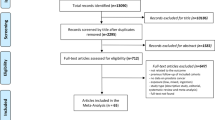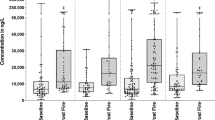Abstract
US Air Force veterans of Operation Ranch Hand sprayed herbicides contaminated with 2,3,7,8-tetrachlorodibenzo-p-dioxin (TCDD) in Vietnam from 1962 to 1971. Comparisons served in Southeast Asia (SEA) during the same time period but did not spray herbicides. Here we investigate a potential association between exposure to TCDD and prostate cancer. Data were available for 2516 veterans (1019 Ranch Hand and 1497 Comparison) who participated in at least one of six physical examinations starting in 1982 and had a measurement of serum TCDD. We assigned Ranch Hands to two exposure categories: Lower and Higher, based on their median 20-year cumulative TCDD level. In total, 81 Comparison and 59 Ranch Hand prostate cancers were identified between 1 January 1982 and 31 December 2003. We found no overall increase in the risk of prostate cancer in Ranch Hand veterans versus the Comparisons. There was a positive association in Ranch Hand veterans in the Higher TCDD category who served in SEA before 1969 (RR=2.27, 95% CI 1.11–4.66) when more contaminated herbicides were used, but the number of cases was small (n=15). A within-group comparison found that in Comparison veterans, time served in SEA was associated with an increased risk of prostate cancer (RR=2.18, 95% CI 1.27–3.76, >789 days versus ≤789 days). No increase in the risk of prostate cancer was observed within the Ranch Hand group in association with TCDD or time served in SEA. These analyses suggest that a longer service in SEA and exposures other than TCDD may have increased the risk of prostate cancer in Comparison veterans.
This is a preview of subscription content, access via your institution
Access options
Subscribe to this journal
Receive 6 print issues and online access
$259.00 per year
only $43.17 per issue
Buy this article
- Purchase on Springer Link
- Instant access to full article PDF
Prices may be subject to local taxes which are calculated during checkout
Similar content being viewed by others
References
Abbott B.D., Lin T.M., Rasmussen N.T., Albrecht R.M., Schmid J.E., and Peterson R.E. Lack of expression of EGF and TGF-alpha in the fetal mouse alters formation of prostatic epithelial buds and influences the response to TCDD. Toxicol Sci 2003: 76 (2): 427–436.
Air Force Health Study (AFHS). An Epidemiologic Investigation of Health Effects in Air Force Personnel Following Exposure to Herbicides. 1997 Follow-up Examination and Results. Science Application International Corporation, Reston, F41624-96-C1012; 2000.
Akhtar F.Z., Garabrant D.H., Ketchum N.S., and Michalek J.E. Cancer in US Air Force veterans of the Vietnam war. J Occup Environ Health 2004: 46: 123–136.
Australian Institute of Health and Welfare (AIHW). Morbidity of Vietnam Veterans: A Study of the Health of Australia's Vietnam Veteran Community. Volume 3: Validation Study. Australian Institute of Health and Welfare, Canberra, 1999.
Aylward L.L., Brunet R.C., Carrier G., Hays S.M., Cushing C.A., Needham L.L., Patterson Jr D.G., Gerthoux P.M., Brambilla P., and Mocarelli P. Concentration-dependent TCDD elimination kinetics in humans: toxicokinetic modeling for moderately to highly exposed adults from Seveso, Italy, and Vienna, Austria, and impact on dose estimates for the NIOSH cohort. J Expo Anal Environ Epidemiol 2005: 15 (1): 51–65.
Becher H., Steindorf K., and Flesch-Janys D. Quantitative cancer risk assessment for dioxins using an occupational cohort. Environ Health Perspect 1998: 106 (Suppl 2): 663–670.
Breslin P., Kang H.K., Lee Y., and Shepard B.M. Proportionate mortality study of US Army and US Marine Corps veterans of the Vietnam War. J Occup Med 1988: 30: 412–419.
Clapp R.W. Update of cancer surveillance of veterans in Massachusetts, USA. Int J Epidemiol 1997: 26: 679–681.
Crane P.J., Bernard D.L., Horsley K.W., and Adena M.A. Mortality of Vietnam Veterans: The Veteran Cohort Study. A Report of the 1996 Retrospective Cohort Study of Australian Vietnam Veterans Department of Veteran Affairs, Canberra, 1997.
Emond C., Michalek J.E., Birnbaum L.S., and DeVito M.J. Use of PBK model with dose-dependent elimination rates predicts higher peak dioxin exposures than previously estimated. Organohalogen Comp 2004: 66: 2625–2629.
Faqi A.S., Dalsenter P.R., Merker H.J., and Chahoud I. Effects on developmental landmarks and reproductive capability of 3,3′,4,4′-tetrachlorobiphenyl and 3,3′,4,4′,5-pentachlorobiphenyl in offspring of rats exposed during pregnancy. Hum Exp Toxicol 1998: 17: 365–372.
Flesch-Janys D., Steindorf K., Gurn P., and Becher H. Estimation of the cumulated exposure to polychlorinated dibenzo-p-dioxins/furans and standardized mortality ratio analysis of cancer mortality by dose in an occupationally exposed cohort. Environ Health Perspect 1998: 106 (Suppl 2): 655–662.
Giri V.N., Cassidy A.E., Beebe-Dimmer J., Ellis L.R., Smith D.C., Bock C.H., and Cooney K.A. Association between Agent Orange and prostate cancer: a pilot case–control study. Urology 2004: 63 (4): 757–760.
Grönberg H. Prostate cancer epidemiology. Lancet 2003: 361: 859–864.
Henriksen G.L., Ketchum N.S., Michalek J.E., and Swaby J.A. Serum dioxin and diabetes mellitus in veterans of Operation Ranch Hand. Epidemiology 1997: 8: 252–258.
Institute of Medicine (IOM). Veterans and Agent Orange, Update 2000. National Academy Press, Washington, DC, 2001.
International Agency for Research on Cancer (IARC). Monographs on the Evaluation of Carcinogenic Risks to Humans Polychlorinated-Para-dioxins and Polychlorinated Dibenzofurans, Vol. 69. IARC, Lyon, France, 1997.
Jana N.R., Sarkar S., Ishizuka M., Yonemoto J., Tohyama C., and Sone H. Comparative effects of 2,3,7,8-tetrachlorodibenzo-p-dioxin on MCF-7, RL95-2, and LNCaP cells: role of target steroid hormones in cellular responsiveness to CYP1A1 induction. Mol Cell Biol Res Commun 2000: 4: 174–180.
Jemal A., Murray T., Ward E., Samuels A., Tiwari R.C., Ghafoor A., Feuer E.J., and Thun M.J. Cancer statistics, 2005. CA Cancer J Clin 2005: 55 (1): 10–30.
Ketchum N.S., Michalek J.E., and Burton E. Serum dioxin and cancer in veterans of operation Ranch Hand. Am J Epidemiol 1999: 149 (7): 630–639.
Ko K., Moore R.W., and Peterson R.E. Aryl hydrocarbon receptors in urogenital sinus mesenchyme mediate the inhibition of prostatic epithelial bud formation by 2,3,7,8-tetrachlorodibenzo-p-dioxin. Toxicol Appl Pharmacol 2004: 196 (1): 149–155.
Ko K., Theobald H.M., and Peterson R.E. In utero and lactational exposure to 2,3,7,8-tetrachlorodibenzo-p-dioxin in the C57BL/6J mouse prostate: lobe-specific effects on branching morphogenesis. Toxicol Sci 2002: 70: 227–237.
Lin T.M., Rasmussen N.T., Moore R.W., Albrecht R.M., and Peterson R.E. 2,3,7,8-tetrachlorodibenzo-p-dioxin inhibits prostatic epithelial bud formation by acting directly on the urogenital sinus. J Urol 2004: 172 (1): 365–368.
Loeffler I.K., and Peterson R.E. Interactive effects of TCDD and p,p′-DDE on male reproductive tract development in utero and lactationally exposed rats. Toxicol Appl Pharmacol 1999: 154: 28–39.
Michalek J.E., Ketchum N.S., and Akhtar F.Z. Post-service mortality of US Air Force veterans occupationally exposed to herbicides in Vietnam: 15-Year follow-up. Am J Epidemiol 1998: 148: 786–792.
Michalek J.E., Pirkle J.L., Needham L.L., Patterson Jr D.G., Caudill S.P., Tripathi R.C., and Mocarelli P. Pharmacokinetics of 2,3,7,8-tetrachlorodibenzo-p-dioxin in Seveso adults and veterans of operation Ranch Hand. J Expo Anal Environ Epidemiol 2002: 2: 44–53.
Michalek J.E., Wolfe W.H., and Miner J.C. Health status of Air Force veterans occupationally exposed to herbicides in Vietnam, II. Mortality. JAMA 1990: 264: 1832–1836.
Notari R.E. Biopharmaceutics and Clinical Pharmacokinetics. An Introduction, 4th edn. Marcel Dekker, New York, 1987.
Pavuk M., Michalek J.E., Schecter A., Ketchum N.S., Akhtar F.Z., and Fox K.A. Did TCDD exposure or service in Southeast Asia increase the risk of cancer in Air Force Vietnam veterans who did not spray Agent Orange? J Occup Environ Med 2005: 47 (4): 335–342.
Pavuk M., Schecter A.J., Akhtar F.Z., and Michalek J.E. Serum 2,3,7,8-tetrachlorodibenzo-p-dioxin (TCDD) levels and thyroid function in Air Force veterans of the Vietnam War. Ann Epidemiol 2003: 13: 335–343.
Roman B.L., Sommer R.J., Shinomiya K., and Peterson R.E. In utero and lactational exposure of the male rat to 2,3,7,8-tetrachlorodibenzo-p-dioxin: impaired prostate growth and development without inhibited androgen production. Toxicol Appl Pharmacol 1995: 134: 241–250.
Schaufler K., Haslmayer P., Jager W., Pec M., and Thalhammer T. The environmental toxin 2,3,7,8-tetrachlorodibenzo-p-dioxin induces cytochrome P450 activity in high passage PC 3 and DU 145 human prostate cancer cell lines. Int J Mol Med 2002: 9: 411–416.
Schecter A., Quynh H.T., Pavuk M., Päpke O., Malisch R., and Constable J.D. Food as a source of dioxin exposure in the residents of Bien Hoa City, Vietnam. J Occup Environ Med 2003: 45: 781–788.
Schrader T.J., and Cooke G.M. Examination of selected food additives and organochlorine food contaminants for androgenic activity in vitro. Toxicol Sci 2000: 53: 278–288.
Simanainen U., Adamsson A., Tuomisto J.T., Miettinen H.M., Toppari J., Tuomisto J., and Viluksela M. Adult 2,3,7,8-tetrachlorodibenzo-p-dioxin (TCDD) exposure and effects on male reproductive organs in three differentially TCDD-susceptible rat lines. Toxicol Sci 2004: 81 (2): 401–407.
Steenland K., Deddens J., and Piacitelli L. Risk assessment for 2,3,7,8-tetrachlorodibenzo-p-dioxin (TCDD) based on an epidemiologic study. Am J Epidemiol 2001: 154: 451–458.
Stellman J.M., Stellman S.D., Christian R., Weber T., and Tomasallo C. The extent and patterns of usage of Agent Orange and other herbicides in Vietnam. Science 2003: 422: 681–687.
Tessier D.M., and Matsumura F. Increased ErbB-2 tyrosine kinase activity, MAPK phosphorylation, and cell proliferation in the prostate cancer cell line LNCaP following treatment by select pesticides. Toxicol Sci 2001: 60: 38–43.
Theobald H.M., Roman B.L., Lin T.M., Ohtani S., Chen S.W., and Peterson R.E. 2,3,7,8-tetrachlorodibenzo-p-dioxin inhibits luminal cell differentiation and androgen responsiveness of the ventral prostate without inhibiting prostatic 5 alpha-dihydrotestosterone formation or testicular androgen production in rat offspring. Toxicol Sci 2000: 58: 324–328.
Timms B.G., Peterson R.E., and vom Saal F.S. 2,3,7,8-tetrachlorodibenzo-p-dioxin interacts with endogenous estradiol to disrupt prostate gland morphogenesis in male rat fetuses. Toxicol Sci 2002: 67: 264–274.
Visintainer P.F., Barone M., McGee H., and Peterson E.L. Proportionate mortality study of Vietnam-era veterans of Michigan. J Occup Environ Med 1995: 37: 423–428.
Watanabe K.K., and Kang H.K. Mortality patterns among Vietnam veterans: a 24-year retrospective analysis. J Occup Environ Med 1996: 38: 272–278.
Wolfe W.H., Michalek J.E., Miner J.C., Rahe A.J., Moore C.A., Needham L.L., and Patterson Jr D.G. Paternal serum dioxin and reproductive outcomes among veterans of Operation Ranch Hand. Epidemiology 1995: 6: 17–22.
Wolfe W.H., Michalek J.E., Miner J.C., Rahe A., Silva M., Thomas W.F., Grubbs W.D., Lustik M.B., Karrison T.G., Roegner R.H., and Williams D.E. Health status of Air Force veterans occupationally exposed to herbicides in Vietnam. I. Physical health. JAMA 1990: 264: 1824–1831.
World Health Organization (WHO). Chapter 22, Malaria. In: Fifty years of the World Health Organization in the Western Pacific Region, Report of the regional director to the regional committee for the Western Pacific. World Health Organization, Geneva, 1998.
World Health Organization (WHO). International Statistical Classification of Diseases and Related Health Problems. Tenth Revision. World Health Organization, Geneva, 1992.
Author information
Authors and Affiliations
Corresponding author
Rights and permissions
About this article
Cite this article
Pavuk, M., Michalek, J. & Ketchum, N. Prostate cancer in US Air Force veterans of the Vietnam war. J Expo Sci Environ Epidemiol 16, 184–190 (2006). https://doi.org/10.1038/sj.jea.7500448
Received:
Accepted:
Published:
Issue Date:
DOI: https://doi.org/10.1038/sj.jea.7500448
Keywords
This article is cited by
-
Association between dioxin and cancer incidence and mortality: a meta-analysis
Scientific Reports (2016)
-
Influence of dioxin exposure upon levels of prostate-specific antigen and steroid hormones in Vietnamese men
Environmental Science and Pollution Research (2016)
-
A critical review of the epidemiology of Agent Orange/TCDD and prostate cancer
European Journal of Epidemiology (2014)
-
High level of dioxin-TEQ in tissue is associated with Agent Orange exposure but not with biochemical recurrence after radical prostatectomy
Prostate Cancer and Prostatic Diseases (2013)
-
The relationship between Agent Orange and prostate specific antigen: a comparison of a hotspot and a non-sprayed area in Vietnam
Environmental Health and Preventive Medicine (2013)



